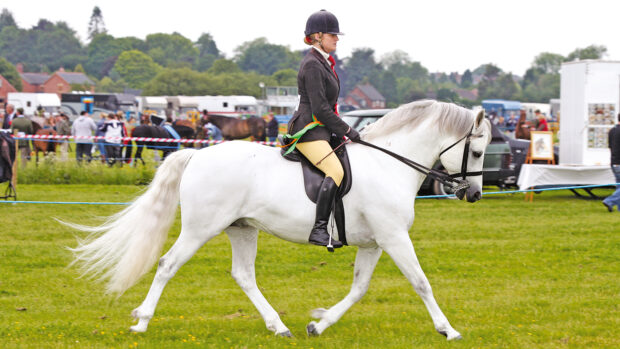Riders are using three times the rein tension horses would select themselves, a pilot study has shown.
The research by Lara Piccolo and Kathrin Kienapfel at the Ruhr-Universität Bochum, Germany showed horses in side reins without a rider voluntarily opted for a contact of around 1kg.
Under saddle, riders were found to be using a significantly higher force of around 3kg to maintain a similar “dressage frame”.
The study set out to explore whether rein tension was generated by horses or riders as well as evaluating the maximum level a horse would maintain of its own will. Its secondary aim was to look at conflict behaviours that arose in relation to rein tension.
A small sample of 13 horses, who had established basic training, were analysed at walk, trot and canter on the lunge and also under saddle with their usual riders.
They were fitted with customised “Animon” rein tension sensors and their behaviour was also videoed so it could later be assessed against an “ethogram”.

.
The findings supported the study’s hypotheses that horses without a rider would adopt the most comfortable rein tension and that horses under saddle would demonstrate the most conflict behaviours.
These behaviours — including tail swishing, bucking, rearing, unusual oral behaviours, laid back ears and “going against the reins” — were five times more common when ridden than lunged.
The authors said that while there were other aspects of “carrying and interacting with a rider that could contribute to discomfort and/or stress”, it appeared that “an improvement of the level of rein tension while riding could lead to less discomfort and therefore fewer expressions of discomfort.”
“The ability of horses to learn depends, among other things, on their mental state. It has been reported that anxiety, for example caused by high pressure on tongue and jaw, results in occurrence of ‘learning blocks’. Therefore, a lighter, more moderate use of the reins could also positively influence learning,” they added.
“A stimulus via the reins should be given with the lowest possible amount of tension, followed by an immediate release after the desired reaction has been achieved.”
The study also noted that it was possible to maintain the “correct dressage position” — which the authors defined as the nose on or slightly in front of the vertical —with a relatively low rein tension.
“Since rein tension may be an aversive stimulus that can cause discomfort or pain, it is important to keep the strength of this stimulus as low as possible. It might therefore be assumed as ideal that while riding, the horse’s self-selected rein tension when equipped with side reins should not be exceeded,” they said.
Continued below…

Tight nosebands can cause distress, study finds
Researchers found horses showed physiological stress responses when wearing a tight crank noseband in combination with a double bridle

Use of spurs, nosebands, bits and draw reins in competition called into question
The six proposals were submitted to the Equestrian Federation of Finland and will be put to vote on 24 April

Subscribe to Horse & Hound magazine today – and enjoy unlimited website access all year round
While the pilot study involved a low sample size, the findings pointed towards the usefulness of further research.
“Since the feasibility is shown, the study will be expanded with higher numbers and small refinements in the study design…to provide a broader insight into horse personality,” the authors concluded.
“A further goal is to make the next step into building a large database on finding the acceptable rein tension for most horses, which does not adversely affect their welfare.”
For all the latest news analysis, competition reports, interviews, features and much more, don’t miss Horse & Hound magazine, on sale every Thursday.





